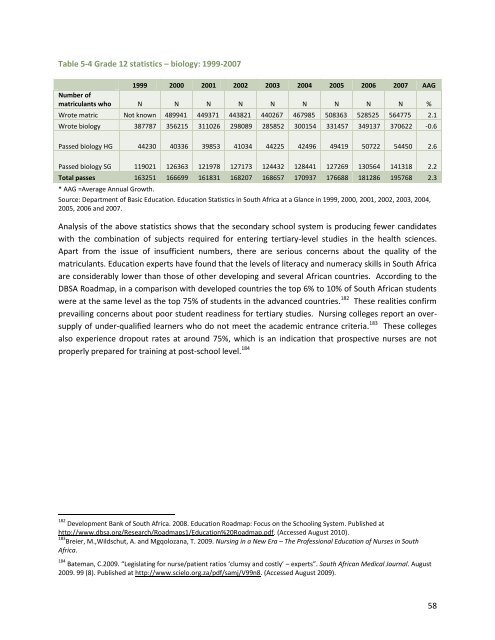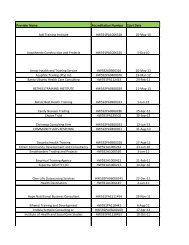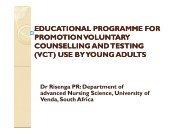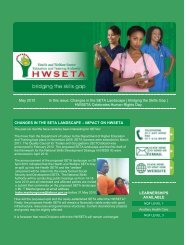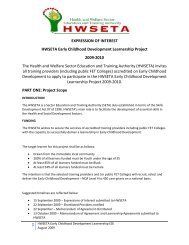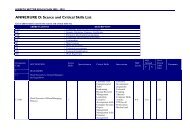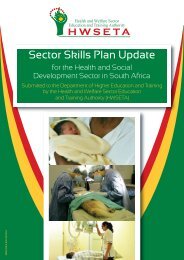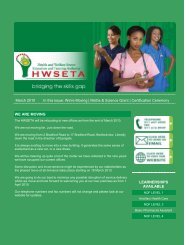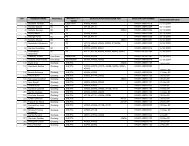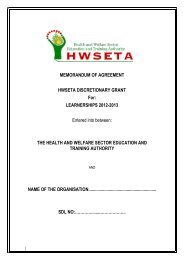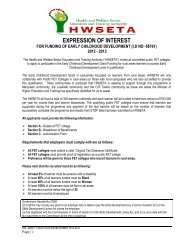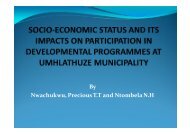sector skills plan for the health sector in south africa
sector skills plan for the health sector in south africa
sector skills plan for the health sector in south africa
You also want an ePaper? Increase the reach of your titles
YUMPU automatically turns print PDFs into web optimized ePapers that Google loves.
Table 5-4 Grade 12 statistics – biology: 1999-2007<br />
1999 2000 2001 2002 2003 2004 2005 2006 2007 AAG<br />
Number of<br />
matriculants who N N N N N N N N N %<br />
Wrote matric Not known 489941 449371 443821 440267 467985 508363 528525 564775 2.1<br />
Wrote biology 387787 356215 311026 298089 285852 300154 331457 349137 370622 -0.6<br />
Passed biology HG 44230 40336 39853 41034 44225 42496 49419 50722 54450 2.6<br />
Passed biology SG 119021 126363 121978 127173 124432 128441 127269 130564 141318 2.2<br />
Total passes 163251 166699 161831 168207 168657 170937 176688 181286 195768 2.3<br />
* AAG =Average Annual Growth.<br />
Source: Department of Basic Education. Education Statistics <strong>in</strong> South Africa at a Glance <strong>in</strong> 1999, 2000, 2001, 2002, 2003, 2004,<br />
2005, 2006 and 2007.<br />
Analysis of <strong>the</strong> above statistics shows that <strong>the</strong> secondary school system is produc<strong>in</strong>g fewer candidates<br />
with <strong>the</strong> comb<strong>in</strong>ation of subjects required <strong>for</strong> enter<strong>in</strong>g tertiary-level studies <strong>in</strong> <strong>the</strong> <strong>health</strong> sciences.<br />
Apart from <strong>the</strong> issue of <strong>in</strong>sufficient numbers, <strong>the</strong>re are serious concerns about <strong>the</strong> quality of <strong>the</strong><br />
matriculants. Education experts have found that <strong>the</strong> levels of literacy and numeracy <strong>skills</strong> <strong>in</strong> South Africa<br />
are considerably lower than those of o<strong>the</strong>r develop<strong>in</strong>g and several African countries. Accord<strong>in</strong>g to <strong>the</strong><br />
DBSA Roadmap, <strong>in</strong> a comparison with developed countries <strong>the</strong> top 6% to 10% of South African students<br />
were at <strong>the</strong> same level as <strong>the</strong> top 75% of students <strong>in</strong> <strong>the</strong> advanced countries. 182 These realities confirm<br />
prevail<strong>in</strong>g concerns about poor student read<strong>in</strong>ess <strong>for</strong> tertiary studies. Nurs<strong>in</strong>g colleges report an oversupply<br />
of under-qualified learners who do not meet <strong>the</strong> academic entrance criteria. 183 These colleges<br />
also experience dropout rates at around 75%, which is an <strong>in</strong>dication that prospective nurses are not<br />
properly prepared <strong>for</strong> tra<strong>in</strong><strong>in</strong>g at post-school level. 184<br />
182 Development Bank of South Africa. 2008. Education Roadmap: Focus on <strong>the</strong> School<strong>in</strong>g System. Published at<br />
http://www.dbsa.org/Research/Roadmaps1/Education%20Roadmap.pdf. (Accessed August 2010).<br />
183 Breier, M.,Wildschut, A. and Mgqolozana, T. 2009. Nurs<strong>in</strong>g <strong>in</strong> a New Era – The Professional Education of Nurses <strong>in</strong> South<br />
Africa.<br />
184 Bateman, C.2009. “Legislat<strong>in</strong>g <strong>for</strong> nurse/patient ratios ‘clumsy and costly’ – experts”. South African Medical Journal. August<br />
2009. 99 (8). Published at http://www.scielo.org.za/pdf/samj/V99n8. (Accessed August 2009).<br />
58


